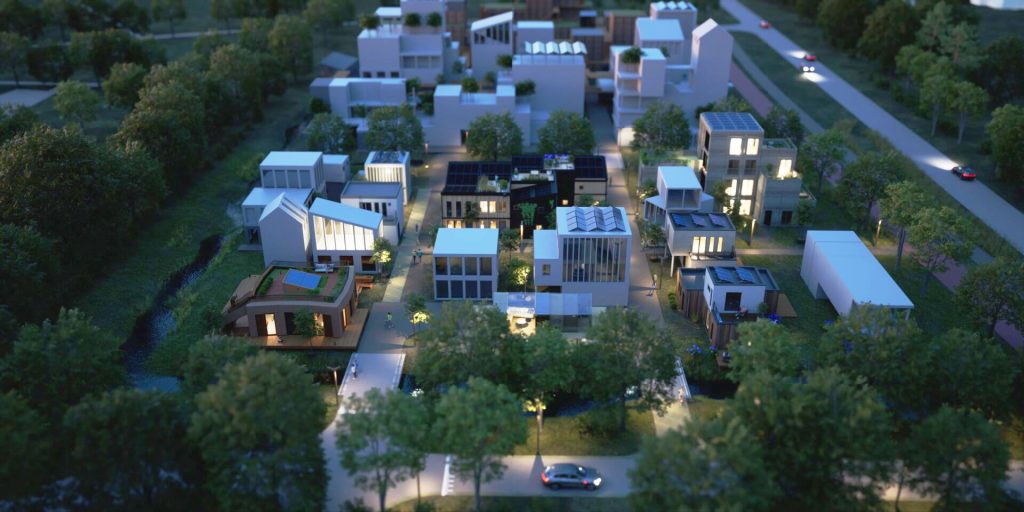Nominations for the 3D Printing Industry Awards 2022 close on Monday. Who do you think should make it to the shortlists for this year’s show? Nominate now; the form closes at the end of the month.
CyBe Construction’s PPVC system for 3D concrete printing reduces traditional construction costs in half – according to CyBe.
CyBe, a global 3D concrete printing company, has plans to produce the first-ever 3D printed four-story apartment in collaboration with Lab040, an Eindhoven-based housing developer. CyBe announced project will use the Prefabricated Prefinished Volumetric Construction (PPVC) method.
“This vision is in the DNA of the CyBe organization. For CyBe, this means enabling companies to build faster with less resources, producing affordable, sustainable, and ecologically durable constructions,” said Berry Hendricks, CEO of CyBe.
CyBe says PPVC can be used to build finished units off-site for installation on-site. 3D modules are created in regulated manufacturing environments using this modular construction technology with optimum building techniques and materials. “CyBe Mortar sets in only three minutes and achieves structural strength in one hour,” the company writes.
The 3D modules can be delivered to the construction site in various states. Quick assembly maintains the concrete’s natural advantages, including thermal bulk, sound absorption, and fire resistance.

CyBe G Gantry – a pathway to sustainable construction
CyBe G Gantry, a 3D concrete printer, can create objects anywhere in a defined three-dimensional area. This system, which consists of four stable columns and three sturdy beams, will be used for PPVC construction. The Gantry is the best option for printing multi-unit, multi-story buildings using PPVC due to its speed and large-scale capabilities – according to CyBe.
Modular PPVC units may be 3D printed around the clock at a factory location and afterwards shipped to the build site where they are joined together. By moving installation tasks off-site, this technique improves the factory environment by lowering noise and dust pollution. With PPVC, the on-site assembly process is also made simpler, requiring less labor and creating a safer working environment.

Economical and eco-friendly living goals
According to CyBe, the maximum Energy Performance Coefficient (EPC) is 0.2, which is a record low for the sector claims CyBe. This statistic equates to decreased costs, in some circumstances, to zero — for gas, water, and light. CyBe highlighted that low CO2 emissions are also indicated, and the process may even be oxygen-positive.
To ensure that cities and other communities are built to be inclusive, safe, resilient, and sustainable, CyBe employs a micro and macro strategy. Several of the Sustainable Development Goals (SDGs) of the United Nations, including SDG 11, Sustainable Cities and Communities, are addressed by CyBe’s all-encompassing business strategy. This is demonstrated through CyBe’s utilization of cost-effective and environmentally friendly building techniques and community-focused activities and programs.
Construction 3D printing
In construction 3D printing, a 3D printer is used to print concrete, or other materials, layer by layer, to create construction components or entire buildings. The often-stated goal of 3D printing in the construction sector is the reduction of production costs associated with material waste. Production time for the building business can be significantly decreased thanks to 3D printing.
However, this is not a clear-cut matter. According to a study from Heriot-Watt University, material costs would have increased by 44% if a two-story structure in the UAE made from precast concrete had been 3D printed instead. The analysis also revealed that using the technique would only produce minor improvements in sustainability, in contrast to the benefits often mentioned by 3D printing construction advocates. In response, many companies at the forefront of 3D printing for construction, including COBOD, Apis Cor, and Black Buffalo 3D, contacted 3D Printing Industry to question the viability of the simulated structure that served as the basis for the conclusions.
Elsewhere, Graz University of Technology‘s (TU Graz) researchers investigated how concrete 3D printing could result in significant material savings for the building industry while reducing CO2 emissions. Cement, a vital component of concrete, is the world’s most frequently used building material; manufacturing cement is known to produce significant amounts of carbon dioxide (CO2).
Using 3D printing, a group of civil engineers and architects from the university’s Institute of Structural Design developed concrete components that are substantially lighter than typical building slabs. They are hoping that their efforts may lessen the adverse effects of building. And in India, Larsen & Toubro Construction (L&T) 3D printed a one-story house. Now, India has its first two-story 3D printed structure. The 65m2 building, constructed using a large-format concrete 3D printer provided by OEM COBOD, is made of a locally produced 3D printable concrete mix created by L&T’s internal team.
Nominations for the 3D Printing Industry Awards 2022 close soon. Who do you think should make it to the shortlists for this year’s show? Nominate now; the form closes at the end of the month.
To stay up to date with the latest 3D printing news, don’t forget to subscribe to the 3D Printing Industry newsletter or follow us on Twitter, or like our page on Facebook.
While you’re here, why not subscribe to our Youtube channel? Featuring discussion, debriefs, video shorts, and webinar replays.
Are you looking for a job in the additive manufacturing industry? Visit 3D Printing Jobs for a selection of roles in the industry.
Featured image shows a model of the 3D printed construction project. Image via CyBe.



